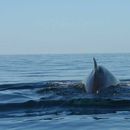en
names in breadcrumbs


Acosmopolitan species, fin whales (Balaenoptera physalus)can be found in all the world’s oceans – from the tropics to polar waters.
Fin whales are the second longest animal in the world and the second largest rorqual (blue whale is no.1).The longest fin whale grew to 27 meters and weighed approximately72 tonnes.Southern hemisphere fin whales tend to be longer than their Northern hemisphere counterparts.
Fin whales are easy to distinguish by their long, slender bodies that are brown-grey on top and white undersides. They have a ridge along their back behind the dorsal fin that contributed to its nickname “razorback.” Fin whales have a very unusual jaw feature: the lower right jaw is white and the lower left jaw is black.
These wonderful whales are usually seen in small family groups of 6 – 10 animals.Mating and calvingoccurs during winter when the whales are in warmer waters. A male while emit a series of repetitive, low-frequency vocalizations to attract a female.Low frequencies travel well in water and attract females from far away. This is important because fin whales do not have specific mating grounds and must communicate to find each other.
During the summer, fin whalesfeedon krill, small schooling fish and squid by lunging into schools of prey with their mouth open.Their baleen plates help sift the food from the water.Fin whales occasionally swim around schools of fish to condense the school so that they increase their catch per dive. Fin whales have long been noted for their extreme speed and are one of the fastest marine mammals, with a cruising speed of nearly 37 km/h. Fin whales can also dive down to roughly 250 m and stay underwater for nearly 15 minutes.
According to theIUCN red list, fin whales are listed as an endangered species.Population decline was caused by commercial whaling for the past three generations.Iceland and Japan still hunt fin whales despite the 1986 Moratorium on whaling.
For more information on MammalMAP, visit the MammalMAPvirtual museumorblog.